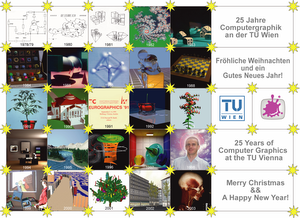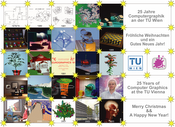Information
- Publication Type: X-Mas Card
- Workgroup(s)/Project(s):
- Date: 2003
Abstract
25 Jahre Computergraphik an der TU WienGeschichte ist eng mit Personen verbunden. Die Geschichte der Computergraphik an der Technischen Universität Wien begann unabhängig voneinander an zwei Instituten. In beiden Fällen entstanden die ersten Diplomarbeiten im Jahr 1978. Eine Initiative begann mit Johann Weiß, der sich mit dem Tracken von Lichtstiften beschäftigte, und Georg Stonawski, der eine Diplomarbeit über GKS schrieb. Die zweite Initiative kam von Prof. Wilhelm Barth, der die zwei Diplomanden Emanuel Wenger und Edwin Scherzer die Programmiersprache Pascal um graphische Elemente erweitern ließ. Im Jahr 1980 begann Werner Purgathofer zusammen mit einigen anderen bei Prof. Barth als Assistent und schloss 1984 seine Dissertation ab. Anschließend baute er zusammen mit Michael Gervautz und anderen eine Computergraphik-Arbeitsgruppe auf, die hauptsächlich im Bereich Rendering aktiv war. Als Werner Purgathofer 1988 Professor wurde, stellte er M. Eduard Gröller ein, der die Arbeitsgruppe für Visualisierung gründete. 1990 wurde das Institut in "Institut für Computergraphik" umbenannt, 1991 organisierte die Gruppe die Jahrestagung der Eurographics in der Wiener Hofburg. Bald danach begann Michael Gervautz im Bereich Virtual Reality zu forschen, woraufhin er 1998 die Spinoff-Firma "Imagination" gründete und Dieter Schmalstieg die Leitung der Virtual Reality-Gruppe übernahm. Anfang 2000 gründete das Institut zusammen mit anderen ein Kompetenzzentrum für Virtual Reality und Visualisierung (VRVis), in dem jetzt Georg Stonawski Geschäftsführer und Helwig Hauser wissenschaftlicher Direktor sind. Nach diesen 25 Jahren arbeiten heute in Wien mehr als 100 Personen im Bereich innovativer Computergraphik.
Die Karte wurde unter Verwendung von Adobe Illustrator und Photoshop auf einem Apple iBook produziert. Für die Farbkalibration des bei der Herstellung der physischen Karten verwendeten Druckers wurde die Software ProfileMaker von Gretag Macbeth verwendet.
Idee: Werner Purgathofer Bilder: Der Meister, Emanuel Wenger, Michael Gervautz, Robert F. Tobler, Michael Feda, Christoph Traxler, Michael Wimmer, Alexander Wilkie, Helwig Hauser, Anton L. Fuhrmann und das Kollektiv der Visualisierungsgruppe Herstellung: Alexander Wilkie
25 Years of Computer Graphics at the TU Vienna
History is strongly connected to people. The history of Computer Graphics at the Vienna University of Technology began independently at two institutes. In both cases the first diploma theses were written in 1978. One initiative was started by Johann Weiss, who implemented the tracking of a light pen, and Georg Stonawski, who wrote a thesis about GKS. The second initiative was by Prof. Wilhelm Barth, who worked with the two diploma students Emanuel Wenger and Edwin Scherzer on extending the programming language Pascal with graphical elements. Amongst others, Werner Purgathofer started to work as an assistant of Prof. Barth in 1980, and finished his PhD in 1984. Together with Michael Gervautz and other colleagues, he then built up a Computer Graphics group that was active mainly in the area of Rendering. When Werner Purgathofer became Professor in 1988, he employed M. Eduard Gröller, who in turn founded a Visualisation research group. In 1990 the institute was renamed to "Institute of Computer Graphics", in 1991 the group organized the annual Eurographics conference in the Vienna Hofburg. Soon after that, Michael Gervautz started research in the area of Virtual Reality, which led to the founding of the spin-off company "Imagination" in 1998. Since then, the Virtual Reality group was led by Dieter Schmalstieg. Together with others, the institute created a competence center for Virtual Reality and Visualisation (VRVis) in January 2000, of which Georg Stonawski is the CEO and Helwig Hauser is the scientific director. After these 25 years, there are now more than 100 people in Vienna working in the field of innovative Computer Graphics.
The card was produced using Adobe Illustrator and Photoshop on an Apple iBook. The colour calibration of the printer used for the production of the pysical cards was performed using Gretag Macbeth ProfileMaker software.
Idea: Werner Purgathofer Images by: The Master, Emanuel Wenger, Michael Gervautz, Robert F. Tobler, Michael Feda, Christoph Traxler, Michael Wimmer, Alexander Wilkie, Helwig Hauser, Anton L. Fuhrmann and the collective of the Visualisation group Production: Alexander Wilkie
Additional Files and Images
Weblinks
No further information available.BibTeX
@xmascard{xmas-2003,
title = "X-Mas 2003",
author = "Werner Purgathofer and Alexander Wilkie",
year = "2003",
abstract = "25 Jahre Computergraphik an der TU Wien Geschichte ist eng
mit Personen verbunden. Die Geschichte der Computergraphik
an der Technischen Universit\"{a}t Wien begann
unabh\"{a}ngig voneinander an zwei Instituten. In beiden
F\"{a}llen entstanden die ersten Diplomarbeiten im Jahr
1978. Eine Initiative begann mit Johann Wei{\ss}, der sich
mit dem Tracken von Lichtstiften besch\"{a}ftigte, und Georg
Stonawski, der eine Diplomarbeit \"{u}ber GKS schrieb. Die
zweite Initiative kam von Prof. Wilhelm Barth, der die zwei
Diplomanden Emanuel Wenger und Edwin Scherzer die
Programmiersprache Pascal um graphische Elemente erweitern
lie{\ss}. Im Jahr 1980 begann Werner Purgathofer zusammen
mit einigen anderen bei Prof. Barth als Assistent und
schloss 1984 seine Dissertation ab. Anschlie{\ss}end baute
er zusammen mit Michael Gervautz und anderen eine
Computergraphik-Arbeitsgruppe auf, die haupts\"{a}chlich im
Bereich Rendering aktiv war. Als Werner Purgathofer 1988
Professor wurde, stellte er M. Eduard Gr\"{o}ller ein, der
die Arbeitsgruppe f\"{u}r Visualisierung gr\"{u}ndete. 1990
wurde das Institut in "Institut f\"{u}r Computergraphik"
umbenannt, 1991 organisierte die Gruppe die Jahrestagung der
Eurographics in der Wiener Hofburg. Bald danach begann
Michael Gervautz im Bereich Virtual Reality zu forschen,
woraufhin er 1998 die Spinoff-Firma "Imagination"
gr\"{u}ndete und Dieter Schmalstieg die Leitung der Virtual
Reality-Gruppe \"{u}bernahm. Anfang 2000 gr\"{u}ndete das
Institut zusammen mit anderen ein Kompetenzzentrum f\"{u}r
Virtual Reality und Visualisierung (VRVis), in dem jetzt
Georg Stonawski Gesch\"{a}ftsf\"{u}hrer und Helwig Hauser
wissenschaftlicher Direktor sind. Nach diesen 25 Jahren
arbeiten heute in Wien mehr als 100 Personen im Bereich
innovativer Computergraphik. Die Karte wurde unter
Verwendung von Adobe Illustrator und Photoshop auf einem
Apple iBook produziert. F\"{u}r die Farbkalibration des bei
der Herstellung der physischen Karten verwendeten Druckers
wurde die Software ProfileMaker von Gretag Macbeth
verwendet. Idee: Werner Purgathofer Bilder: Der Meister,
Emanuel Wenger, Michael Gervautz, Robert F. Tobler, Michael
Feda, Christoph Traxler, Michael Wimmer, Alexander Wilkie,
Helwig Hauser, Anton L. Fuhrmann und das Kollektiv der
Visualisierungsgruppe Herstellung: Alexander Wilkie 25
Years of Computer Graphics at the TU Vienna History is
strongly connected to people. The history of Computer
Graphics at the Vienna University of Technology began
independently at two institutes. In both cases the first
diploma theses were written in 1978. One initiative was
started by Johann Weiss, who implemented the tracking of a
light pen, and Georg Stonawski, who wrote a thesis about
GKS. The second initiative was by Prof. Wilhelm Barth, who
worked with the two diploma students Emanuel Wenger and
Edwin Scherzer on extending the programming language Pascal
with graphical elements. Amongst others, Werner Purgathofer
started to work as an assistant of Prof. Barth in 1980, and
finished his PhD in 1984. Together with Michael Gervautz and
other colleagues, he then built up a Computer Graphics group
that was active mainly in the area of Rendering. When Werner
Purgathofer became Professor in 1988, he employed M. Eduard
Gr\"{o}ller, who in turn founded a Visualisation research
group. In 1990 the institute was renamed to "Institute of
Computer Graphics", in 1991 the group organized the annual
Eurographics conference in the Vienna Hofburg. Soon after
that, Michael Gervautz started research in the area of
Virtual Reality, which led to the founding of the spin-off
company "Imagination" in 1998. Since then, the Virtual
Reality group was led by Dieter Schmalstieg. Together with
others, the institute created a competence center for
Virtual Reality and Visualisation (VRVis) in January 2000,
of which Georg Stonawski is the CEO and Helwig Hauser is the
scientific director. After these 25 years, there are now
more than 100 people in Vienna working in the field of
innovative Computer Graphics. The card was produced using
Adobe Illustrator and Photoshop on an Apple iBook. The
colour calibration of the printer used for the production of
the pysical cards was performed using Gretag Macbeth
ProfileMaker software. Idea: Werner Purgathofer Images by:
The Master, Emanuel Wenger, Michael Gervautz, Robert F.
Tobler, Michael Feda, Christoph Traxler, Michael Wimmer,
Alexander Wilkie, Helwig Hauser, Anton L. Fuhrmann and the
collective of the Visualisation group Production: Alexander
Wilkie ",
URL = "https://www.cg.tuwien.ac.at/research/publications/2003/xmas-2003/",
}


